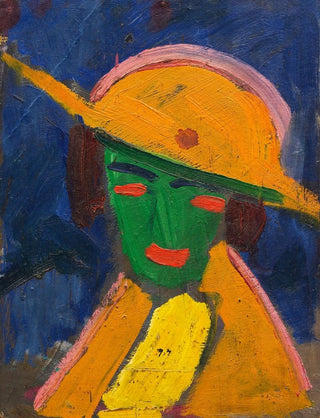Art print | Green woman with yellow hat I - Hermann Stenner


View from behind

Frame (optional)
Femme green with yellow hat I - Hermann Stenner – Captivating introduction
The "Femme verte avec chapeau jaune I" by Hermann Stenner is a work that transcends the simple frame of painting to establish itself as a true exploration of color and form. This iconic piece, which captures the essence of emerging modernity in the early 20th century, embodies a bold and vibrant vision of femininity. Through its shades of green and yellow, Stenner manages to create a visual dialogue between the subject and its environment, inviting the viewer to immerse themselves in a world where each hue tells a story. The art print of this work not only allows appreciation of its beauty but also encourages reflection on the emotions and ideas it evokes.
Style and uniqueness of the work
Stenner's style is distinguished by his daring approach to color and light. In "Femme verte avec chapeau jaune I," the forms blend with remarkable fluidity, while the vibrant colors intertwine to create a piece that is both dynamic and harmonious. The artist plays with contrasts, highlighting the deep green of the dress that envelops the female silhouette, while opposing the brightness of the yellow hat. This duality creates a captivating visual tension, prompting the observer to question the relationship between the subject and its environment. The composition, although figurative, moves away from traditional conventions, offering a modernist vision that still resonates today. Every brushstroke seems charged with emotion, bearing witness to the intensity of the feelings Stenner sought to convey.
The artist and his influence
Hermann Stenner, an emblematic figure of German expressionism, knew how to mark his era with his ability to translate the tumult of his time through his art. Born in 1885, he was influenced by the artistic movements surrounding him, notably Fauvism and Cubism. His unique vision, which combines modern sensitivity with a deep understanding of artistic traditions, made him a pioneer in exploring color as an emotional language. Stenner often depicted themes related to the human condition, beauty, and

Matte finish

View from behind

Frame (optional)
Femme green with yellow hat I - Hermann Stenner – Captivating introduction
The "Femme verte avec chapeau jaune I" by Hermann Stenner is a work that transcends the simple frame of painting to establish itself as a true exploration of color and form. This iconic piece, which captures the essence of emerging modernity in the early 20th century, embodies a bold and vibrant vision of femininity. Through its shades of green and yellow, Stenner manages to create a visual dialogue between the subject and its environment, inviting the viewer to immerse themselves in a world where each hue tells a story. The art print of this work not only allows appreciation of its beauty but also encourages reflection on the emotions and ideas it evokes.
Style and uniqueness of the work
Stenner's style is distinguished by his daring approach to color and light. In "Femme verte avec chapeau jaune I," the forms blend with remarkable fluidity, while the vibrant colors intertwine to create a piece that is both dynamic and harmonious. The artist plays with contrasts, highlighting the deep green of the dress that envelops the female silhouette, while opposing the brightness of the yellow hat. This duality creates a captivating visual tension, prompting the observer to question the relationship between the subject and its environment. The composition, although figurative, moves away from traditional conventions, offering a modernist vision that still resonates today. Every brushstroke seems charged with emotion, bearing witness to the intensity of the feelings Stenner sought to convey.
The artist and his influence
Hermann Stenner, an emblematic figure of German expressionism, knew how to mark his era with his ability to translate the tumult of his time through his art. Born in 1885, he was influenced by the artistic movements surrounding him, notably Fauvism and Cubism. His unique vision, which combines modern sensitivity with a deep understanding of artistic traditions, made him a pioneer in exploring color as an emotional language. Stenner often depicted themes related to the human condition, beauty, and






